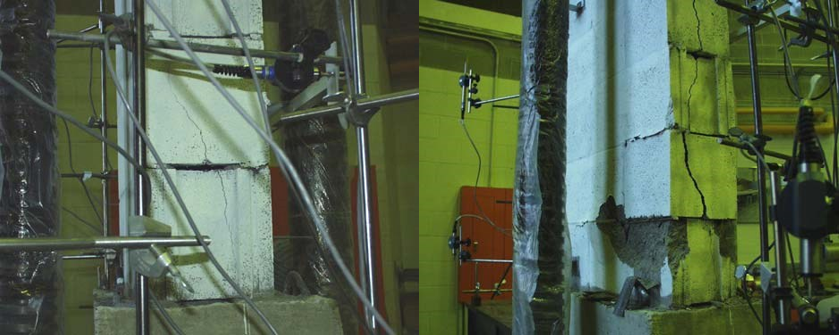Paturova1, B.F. Sparling2 and L.D. Wegner3
- Structural Engineer, AMEC Americas Ltd., #301 – 121 Research Drive, Saskatoon, SK, S7N 4L8, anna.paturova@amec.com
- Professor, Department of Civil and Geological Engineering, University of Saskatchewan, Saskatoon, SK, S7N 5A9, Canada, bruce.sparling@usask.ca
- Associate Professor, Department of Civil and Geological Engineering, University of Saskatchewan, Saskatoon, SK, S7N 5A9, Canada, leon.wegner@usask.ca
ABSTRACT
An experimental study was undertaken to investigate the influence of vertical reinforcement and lateral confinement on the axial strength and ductility of short, partially grouted concrete masonry block walls. Three types of test specimens were considered: unreinforced specimens with a grouted cell; specimens with a grouted cell and vertical reinforcement; and specimens with a grouted cell, vertical reinforcement and lateral confinement placed within the grouted cell. A total of thirty wall specimens, each 1000 mm high by 590 mm wide, were constructed in running bond using standard 200 mm hollow concrete masonry blocks; the central cell of each specimen was grouted. The wall specimens were tested monotonically to failure under axial loading. In addition to the applied load, axial displacements were measured at 14 locations to determine both overall axial deformations and average strains. Cracking patterns and failure modes were also monitored and recorded. Test results indicated that vertical reinforcement in the grouted cores did not have a significant effect on the axial strength of the wall specimens. Due to problems with ensuring adequate compaction of the grout, lateral confinement provided by spiral reinforcement within the cells actually caused a slight reduction in the average axial strength. On the other hand, both the vertical reinforcement and lateral confinement tended to increase the post-peak ductility of the walls. The dominant failure mode observed in all three types of wall specimens featured vertical cracking that progressed through the end webs of the specimens, followed by compressive spalling in the face shell.
KEYWORDS: concrete masonry walls, axial strength, reinforcement, confinement, ductility
B1-4



